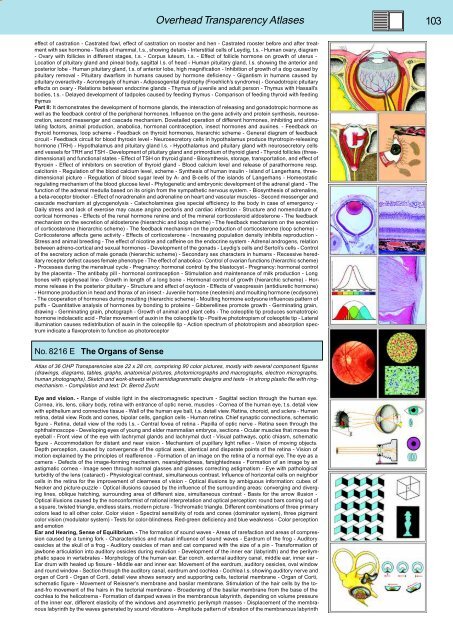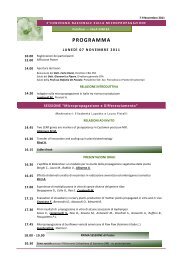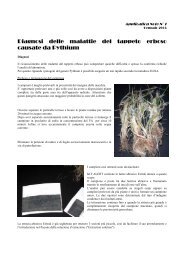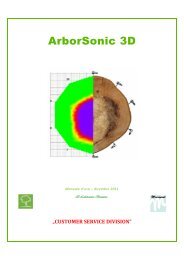BIOLOGY - microscopia.info
BIOLOGY - microscopia.info
BIOLOGY - microscopia.info
Create successful ePaper yourself
Turn your PDF publications into a flip-book with our unique Google optimized e-Paper software.
Overhead Transparency Atlases<br />
103<br />
effect of castration - Castrated fowl, effect of castration on rooster and hen - Castrated rooster before and after treatment<br />
with sex hormone - Testis of mammal, t.s., showing details - Interstitial cells of Leydig, t.s. - Human ovary, diagram<br />
- Ovary with follicles in different stages, t.s. - Corpus luteum, t.s. - Effect of follicle hormone on growth of uterus -<br />
Location of pituitary gland and pineal body, sagittal l.s. of head - Human pituitary gland, l.s. showing the anterior and<br />
posterior lobe - Human pituitary gland, t.s. of anterior lobe, high magnification - Inhibition of growth of a dog caused by<br />
pituitary removal - Pituitary dwarfism in humans caused by hormone deficiency - Gigantism in humans caused by<br />
pituitary overactivity - Acromegaly of human - Adiposogenital dystrophy (Froehlich’s syndrome) - Gonadotropic pituitary<br />
effects on ovary - Relations between endocrine glands - Thymus of juvenile and adult person - Thymus with Hassall’s<br />
bodies, t.s. - Delayed development of tadpoles caused by feeding thymus - Comparison of feeding thyroid with feeding<br />
thymus<br />
Part II: It demonstrates the development of hormone glands, the interaction of releasing and gonadotropic hormone as<br />
well as the feedback control of the peripheral hormones. Influence on the gene activity and protein synthesis, neurosecretion,<br />
second messenger and cascade mechanism. Dovetailed operation of different hormones, inhibiting and stimulating<br />
factors, animal production, anabolica, hormonal contraception, insect hormones and auxines. - Feedback on<br />
thyroid hormones, loop scheme - Feedback on thyroid hormones, hierarchic scheme - General diagram of feedback<br />
circuit - Feedback circuit for blood thyroxin level - Neurosecretory cells in hypothalamus produce thyrotropin-releasing<br />
hormone (TRH) - Hypothalamus and pituitary gland l.s. - Hypothalamus and pituitary gland with neurosecretory cells<br />
and vessels for TRH and TSH - Development of pituitary gland and primordium of thyroid gland - Thyroid follicles (threedimensional)<br />
and functional states - Effect of TSH on thyroid gland - Biosynthesis, storage, transportation, and effect of<br />
thyroxin - Effect of inhibitors on secretion of thyroid gland - Blood calcium level and release of parathormone resp.<br />
calcitonin - Regulation of the blood calcium level, scheme - Synthesis of human insulin - Island of Langerhans, threedimensional<br />
picture - Regulation of blood sugar level by A- and B-cells of the islands of Langerhans - Homeostatic<br />
regulating mechanism of the blood glucose level - Phylogenetic and embryonic development of the adrenal gland - The<br />
function of the adrenal medulla based on its origin from the sympathetic nervous system. - Biosynthesis of adrenaline,<br />
a beta-receptor blocker - Effect of noradrenalin and adrenaline on heart and vascular muscles - Second messenger and<br />
cascade mechanism at glycogenolysis - Catecholamines give special efficiency to the body in case of emergency -<br />
Daily stress and lack of exercise may cause angina pectoris and cardiac infarction - Structure and nomenclature of<br />
cortical hormones - Effects of the renal hormone renine and of the mineral corticosteroid aldosterone - The feedback<br />
mechanism on the secretion of aldosterone (hierarchic and loop scheme) - The feedback mechanism on the secretion<br />
of corticosterone (hierarchic scheme) - The feedback mechanism on the production of corticosterone (loop scheme) -<br />
Corticosterone affects gene activity - Effects of corticosterone - Increasing population density inhibits reproduction -<br />
Stress and animal breeding - The effect of nicotine and caffeine on the endocrine system - Adrenal androgens, relation<br />
between adreno-cortical and sexual hormones - Development of the gonads - Leydig’s cells and Sertoli’s cells - Control<br />
of the secretory action of male gonads (hierarchic scheme) - Secondary sex characters in humans - Recessive hereditary<br />
receptor defect causes female phenotype - The effect of anabolica - Control of ovarian functions (hierarchic scheme)<br />
- Processes during the menstrual cycle - Pregnancy: hormonal control by the blastocyst - Pregnancy: hormonal control<br />
by the placenta - The antibaby pill - hormonal contraception - Stimulation and maintenance of milk production - Long<br />
bones with epiphyseal line - Growth in length of a long bone - Hormonal control of growth (hierarchic scheme) - Hormone<br />
release in the posterior pituitary - Structure and effect of oxytocin - Effects of vasopressin (antidiuretic hormone)<br />
- Hormone production in head and thorax of an insect - Juvenile hormone (neotenin) and moulting hormone (ecdysone)<br />
- The cooperation of hormones during moulting (hierarchic scheme) - Moulting hormone ecdysone influences pattern of<br />
puffs - Quantitative analysis of hormones by bonding to proteins - Gibberellines promote growth - Germinating grain,<br />
drawing - Germinating grain, photograph - Growth of animal and plant cells - The coleoptile tip produces somatotropic<br />
hormone indolacetic acid - Polar movement of auxin in the coleoptile tip - Positive phototropism of coleoptile tip - Lateral<br />
illumination causes redistribution of auxin in the coleoptile tip - Action spectrum of phototropism and absorption spectrum<br />
indicate a flavoprotein to function as photoreceptor<br />
No. 8216 E The Organs of Sense<br />
Atlas of 36 OHP Transparencies size 22 x 28 cm, comprising 90 color pictures, mostly with several component figures<br />
(drawings, diagrams, tables, graphs, anatomical pictures, photomicrographs and macrographs, electron micrographs,<br />
human photographs). Sketch and work-sheets with semidiagrammatic designs and texts - In strong plastic file with ringmechanism.<br />
- Compilation and text: Dr. Bernd Zucht<br />
Eye and vision. - Range of visible light in the electromagnetic spectrum - Sagittal section through the human eye.<br />
Cornea, iris, lens, ciliary body, retina with entrance of optic nerve, muscles - Cornea of the human eye, t.s. detail view<br />
with epithelium and connective tissue - Wall of the human eye ball, t.s. detail view. Retina, choroid, and sclera - Human<br />
retina, detail view. Rods and cones, bipolar cells, ganglion cells - Human retina. Chief synaptic connections, schematic<br />
figure - Retina, detail view of the rods l.s. - Central fovea of retina - Papilla of optic nerve - Retina seen through the<br />
ophthalmoscope - Developing eyes of young and elder mammalian embryos, sections - Ocular muscles that moves the<br />
eyeball - Front view of the eye with lachrymal glands and lachrymal duct - Visual pathways, optic chiasm, schematic<br />
figure - Accommodation for distant and near vision - Mechanism of pupillary light reflex - Vision of moving objects.<br />
Depth perception, caused by convergence of the optical axes, identical and disparate points of the retina - Vision of<br />
motion explained by the principles of reafference - Formation of an image on the retina of a normal eye. The eye as a<br />
camera - Defects of the image-forming mechanism, nearsightedness, farsightedness - Formation of an image by an<br />
astigmatic cornea - Image seen through normal glasses and glasses correcting astigmatism - Eye with pathological<br />
turbidity of the lens (cataract) - Physiological contrast, simultaneous contrast. Influence of horizontal cells on neighbor<br />
cells in the retina for the improvement of clearness of vision - Optical illusions by ambiguous <strong>info</strong>rmation: cubes of<br />
Necker and picture-puzzle - Optical illusions caused by the influence of the surrounding areas: converging and diverging<br />
lines, oblique hatching, surrounding area of different size, simultaneous contrast - Basis for the arrow illusion -<br />
Optical illusions caused by the nonconformist of rational interpretation and optical perception: round bars coming out of<br />
a square, twisted triangle, endless stairs, modern picture - Trichromatic triangle. Different combinations of three primary<br />
colors lead to all other color. Color vision - Spectral sensitivity of rods and cones (dominator system), three pigment<br />
color vision (modulator system) - Tests for color-blindness. Red-green deficiency and blue weakness - Color perception<br />
and emotion<br />
Ear and Hearing, Sense of Equilibrium. - The formation of sound waves - Areas of rarefaction and areas of compression<br />
caused by a tuning fork - Characteristics and mutual influence of sound waves - Eardrum of the frog - Auditory<br />
ossicles at the skull of a frog - Auditory ossicles of man and cat compared with the size of a pin - Transformation of<br />
jawbone articulation into auditory ossicles during evolution - Development of the inner ear (labyrinth) and the perilymphatic<br />
space in vertebrates - Morphology of the human ear. Ear conch, external auditory canal, middle ear, inner ear -<br />
Ear drum with healed up fissure - Middle ear and inner ear. Movement of the eardrum, auditory ossicles, oval window<br />
and round window - Section through the auditory canal, eardrum and cochlea - Cochlea l.s. showing auditory nerve and<br />
organ of Corti - Organ of Corti, detail view shows sensory and supporting cells, tectorial membrane - Organ of Corti,<br />
schematic figure - Movement of Reissner’s membrane and basilar membrane. Stimulation of the hair cells by the toand-fro<br />
movement of the hairs in the tectorial membrane - Broadening of the basilar membrane from the base of the<br />
cochlea to the helicotrema - Formation of damped waves in the membranous labyrinth, depending on volume pressure<br />
of the inner ear, different elasticity of the windows and asymmetric perilymph masses - Displacement of the membranous<br />
labyrinth by the waves generated by sound vibrations - Amplitude pattern of vibration of the membranous labyrinth







